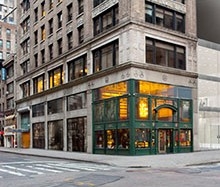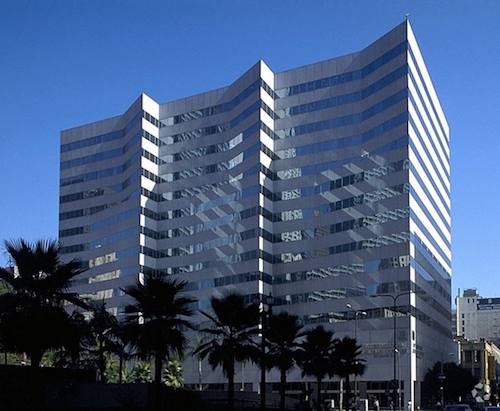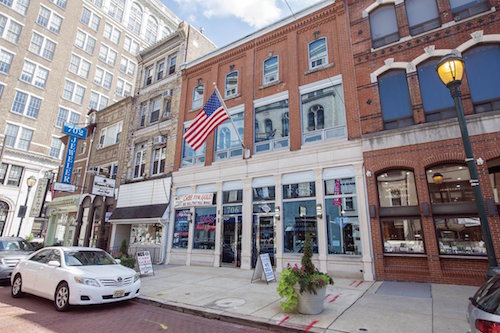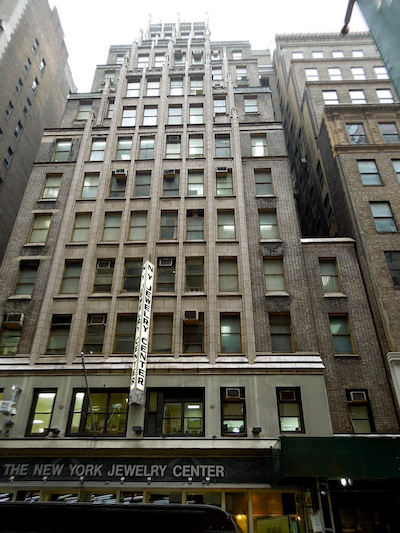Articles and News
Will Redevelopment Save Or Kill America’s Famed Jewelry Districts? | August 17, 2016 (0 comments)

Merrick, NY—As the jewelry industry shrinks, developers are salivating. Big city jewelry centers have had a major role in the industry for more than 100 years, but tradition matters not to realty companies eyeing their prime locations. From New York’s 47th Street to Los Angeles’s Hill Street, buildings that once were bursting with small, family-owned jewelry companies are slowly converting to non-jewelry offices, residential and mixed-use, adding non-jewelry retail tenants, or simply coming down to be replaced with something that brings bigger rents.
For example, a February 2016 article in the Los Angeles Times details how some of the jewelry district’s iconic buildings have changed owners and/or tenants, such as the Burlington Coat Factory discount apparel chain that now occupies the bottom two floors of the St. Vincent Jewelry Center. Both the International Jewelry Mart and the Foreman and Clark buildings—both historic—have been sold to large real estate firms, and the scuttlebutt is that they will be repurposed for residential or mixed use.
Mike Condon, an executive with realty company Cushman & Wakefield, told the Times that even if the Hill Street jewelry district isn’t thriving as much as it once was, the buildings themselves are both ideal and in demand for other uses like hotels, residences, and creative office and retail space.
Uneek Jewelry is in the International building at 550 Hill St., one that the Times article says is supposed to be repurposed. But CEO Benjamin Javaheri isn’t fazed. Unlike the “wholesale-to-the-public” companies that dot the district, Uneek does not sell directly to consumers at all, he says. The company is in growth mode, adding headcount to both corporate and production, and last year invested heavily a new office, consolidating its operations from offices on two separate levels to a much larger space on the top floor.

550 Hill St, a major jewelry center in Los Angeles, is not slated for demolition but the new owner likely will bring in non-jewelry tenants, changing the character of the building.
In Philadelphia, Jewelers’ Row tenants were stunned to learn that the city just approved a local developer’s plans to demolish five properties along their historic block of Sansom Street, and build a 16-story, 80-unit residential tower. While Jewelers Row is much smaller than its New York and Los Angeles counterparts, it is the oldest diamond district in the nation and tenants value its history. Toll Brothers, the developer, specializes in luxury residential and has said it plans a building that both blends in with the historic character of the street and keeps the ground level as retail for jewelers, but according to the Philadelphia Inquirer, the developer’s plans were somehow kept under wraps and jewelers only learned about the proposed tower after the demolition permit was approved. A group immediately sprang into action to protest the demolition and preserve the history of the district.

A sizable group of Jewelers' Row buildings on Philadelphia's Sansom Street are slated for demolition. Image: Philadelphia Inquirer
Not everyone on Sansom Street is opposed to introducing new development. As the jewelry industry shrinks, jewelry districts must adapt if they’re to remain vibrant neighborhoods. Asaf Herskovitz, CEO of GN Diamond there, has observed the decline of Jewelers Row for some time and thinks the proposed residence will be good for both the city and the neighborhood.
“Things are changing. I just want it to be as positive as it can be,” he told The Centurion. “As more people [come to] live in the area it will help the remaining businesses because there are more affluent clients living on the street.”
And in New York, 10 buildings in its famed Diamond District along 47th Street potentially face the wrecking ball. Extell Development—the company behind the gleaming new International Gem Tower at 50 W. 47th Street—last month received permission from the city to demolish an iconic jewelry building at 10 W. 47th Street. This comes on the heels of a permit issued in May to raze two other buildings in the district, 562-564 Fifth Avenue (top of page), between 46th and 47th Streets, just a short walk from prime tourist attractions like Rockefeller Center, St. Patrick’s Cathedral, and Radio City Music Hall. The ground floor once housed a Bank Leumi, which pulled out of U.S. diamond lending in 2014.
“We don’t know what the new owner plans to do with them,” says Michael Grumet, executive director of the 47th Street Business Improvement District. He confirmed that they’ve been emptied of tenants, but he says any other information at this time is simply rumor.
The location, however, is pure catnip to developers. The price of space in the diamond district is among the most expensive real estate in New York, says Grumet. The block encompassing 46th and 47th Streets between Fifth and Sixth Avenues has a number of smaller buildings—unusual for midtown Manhattan—and Extell already has permission to level about 10 buildings there.

Going, going, almost gone: 10 W. 47th Street in New York City has been emptied of tenants and is slated for demolition soon.
“It’s all dependent on the economy and timing and what the developers want to do. It’s out of our control. When you buy a building in the city, unless it’s residential, more than likely they’ll take it down and do something else,” Grumet told The Centurion.
Some of the displaced tenants from the 10 and 562-564 buildings were able to find new space in the diamond district, but Grumet acknowledges that many weren’t. Jeff Feero, managing partner at Alex Sepkus on 48th Street, says most small shops can’t afford to move into the pricey International Gem Tower. But with less space now available in the older buildings, those rents are rising fast too.
Some of the displaced tenants simply retired, says Grumet, while others had no choice but to move out of the jewelry district. But leaving the district isn’t as easy as it sounds. Rents may be lower, but Feero points out that it’s not just the location itself that makes the district, it’s also about having essential support services and suppliers a few feet away, not miles away.
“Even the parking garage on our street is gone, on the other side of 48th Street and Sixth Avenue. All the Sam Ash [music store] buildings are now empty, waiting for demo. Music Row is gone, is Jewelry Row next?” he asks.
Grumet says no. “47th Street will always be the center of the jewelry industry. Will it change? Yes. But we will always be the center of retailing, wholesaling, and diamond trading for the American jewelry and diamond industry.”







